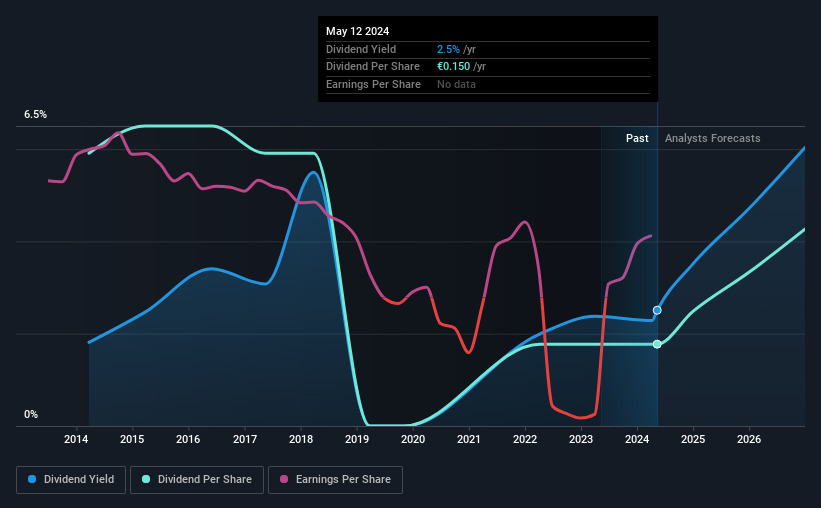Regular readers will know that we love our dividends at Simply Wall St, which is why it’s exciting to see ElringKlinger AG (ETR:ZIL2) is about to trade ex-dividend in the next four days. Typically, the ex-dividend date is one business day before the record date which is the date on which a company determines the shareholders eligible to receive a dividend. The ex-dividend date is of consequence because whenever a stock is bought or sold, the trade takes at least two business day to settle. Therefore, if you purchase ElringKlinger’s shares on or after the 17th of May, you won’t be eligible to receive the dividend, when it is paid on the 21st of May.
The company’s upcoming dividend is €0.15 a share, following on from the last 12 months, when the company distributed a total of €0.15 per share to shareholders. Looking at the last 12 months of distributions, ElringKlinger has a trailing yield of approximately 2.5% on its current stock price of €5.98. Dividends are an important source of income to many shareholders, but the health of the business is crucial to maintaining those dividends. As a result, readers should always check whether ElringKlinger has been able to grow its dividends, or if the dividend might be cut.
View our latest analysis for ElringKlinger
Dividends are typically paid from company earnings. If a company pays more in dividends than it earned in profit, then the dividend could be unsustainable. ElringKlinger paid out just 21% of its profit last year, which we think is conservatively low and leaves plenty of margin for unexpected circumstances.
Click here to see the company’s payout ratio, plus analyst estimates of its future dividends.
Have Earnings And Dividends Been Growing?
Companies that aren’t growing their earnings can still be valuable, but it is even more important to assess the sustainability of the dividend if it looks like the company will struggle to grow. If earnings decline and the company is forced to cut its dividend, investors could watch the value of their investment go up in smoke. It’s not encouraging to see that ElringKlinger’s earnings are effectively flat over the past five years. We’d take that over an earnings decline any day, but in the long run, the best dividend stocks all grow their earnings per share. Growth has been anaemic. Yet with more than 75% of its earnings being kept in the business, there is ample room to reinvest in growth or lift the payout ratio – either of which could increase the dividend.
Another key way to measure a company’s dividend prospects is by measuring its historical rate of dividend growth. ElringKlinger has seen its dividend decline 11% per annum on average over the past 10 years, which is not great to see.
To Sum It Up
Is ElringKlinger worth buying for its dividend? Earnings per share have been flat in recent years, although ElringKlinger reinvests more than half its earnings in the business, which could suggest there are some growth projects that have not yet reached fruition. In summary, ElringKlinger appears to have some promise as a dividend stock, and we’d suggest taking a closer look at it.
So while ElringKlinger looks good from a dividend perspective, it’s always worthwhile being up to date with the risks involved in this stock. For example, we’ve found 2 warning signs for ElringKlinger that we recommend you consider before investing in the business.
Generally, we wouldn’t recommend just buying the first dividend stock you see. Here’s a curated list of interesting stocks that are strong dividend payers.
Have feedback on this article? Concerned about the content? Get in touch with us directly. Alternatively, email editorial-team (at) simplywallst.com.
This article by Simply Wall St is general in nature. We provide commentary based on historical data and analyst forecasts only using an unbiased methodology and our articles are not intended to be financial advice. It does not constitute a recommendation to buy or sell any stock, and does not take account of your objectives, or your financial situation. We aim to bring you long-term focused analysis driven by fundamental data. Note that our analysis may not factor in the latest price-sensitive company announcements or qualitative material. Simply Wall St has no position in any stocks mentioned.
